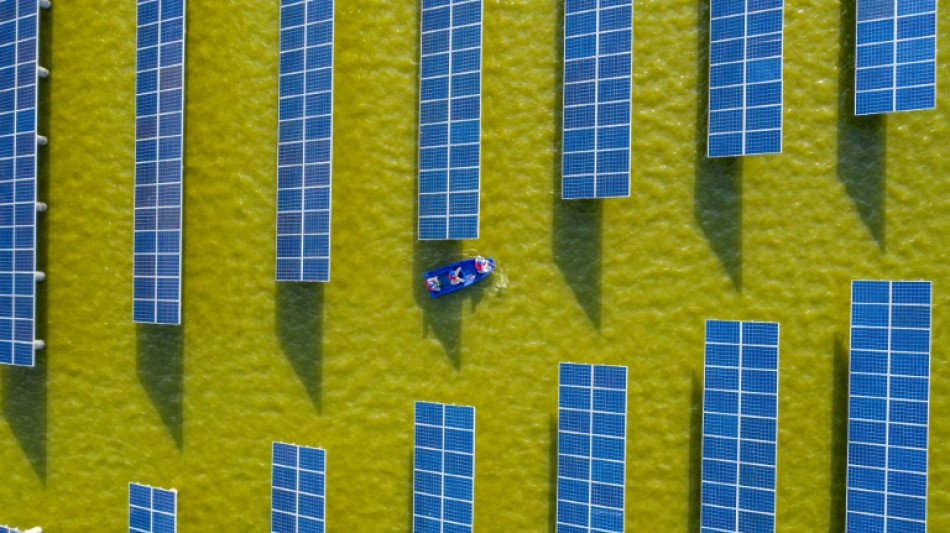
-
 Kagiyama, Yoshida put Japan on top at Finland Grand Prix
Kagiyama, Yoshida put Japan on top at Finland Grand Prix
-
Alcaraz eyeing triumphant Davis Cup farewell for Nadal after ATP Finals exit

-
 Xi, Biden at Asia-Pacific summit under Trump trade war cloud
Xi, Biden at Asia-Pacific summit under Trump trade war cloud
-
India go on record six-hitting spree against South Africa

-
 France skipper Dupont says All Blacks 'back to their best'
France skipper Dupont says All Blacks 'back to their best'
-
Trump pressures US Senate with divisive cabinet picks

-
 Bagnaia strikes late in Barcelona practice to edge title rival Martin
Bagnaia strikes late in Barcelona practice to edge title rival Martin
-
High-ball hero Steward ready to 'front up' against South Africa

-
 Leader of Spain flood region admits 'mistakes'
Leader of Spain flood region admits 'mistakes'
-
Swiatek, Linette take Poland past Spain into BJK Cup quarter-finals

-
 Leftist voices seek to be heard at Rio's G20 summit
Leftist voices seek to be heard at Rio's G20 summit
-
Wales coach Jenkins urges players to 'get back on the horse'

-
 Zverev reaches ATP Finals last four, Alcaraz out
Zverev reaches ATP Finals last four, Alcaraz out
-
Boeing strike will hurt Ethiopian Airlines growth: CEO

-
 Springboks skipper Kolisi wary of England's 'gifted' Smith
Springboks skipper Kolisi wary of England's 'gifted' Smith
-
End of a love affair: news media quit X over 'disinformation'

-
 US finalizes up to $6.6 bn funding for chip giant TSMC
US finalizes up to $6.6 bn funding for chip giant TSMC
-
Scholz urges Ukraine talks in first call with Putin since 2022

-
 Zverev reaches ATP Finals last four, Alcaraz on brink of exit
Zverev reaches ATP Finals last four, Alcaraz on brink of exit
-
Lebanon rescuer picks up 'pieces' of father after Israel strike

-
 US retail sales lose steam in October after hurricanes
US retail sales lose steam in October after hurricanes
-
Zverev reaches ATP Finals last four with set win against Alcaraz

-
 Kerevi back for Australia against Wales, Suaalii on bench
Kerevi back for Australia against Wales, Suaalii on bench
-
Spate of child poisoning deaths sparks S.Africa xenophobia

-
 Comedian Conan O'Brien to host Oscars
Comedian Conan O'Brien to host Oscars
-
Rozner overtakes McIlroy and Hatton for Dubai lead

-
 Mourners bid farewell to medic killed in east Ukraine
Mourners bid farewell to medic killed in east Ukraine
-
Gore says 'absurd' to hold UN climate talks in petrostates

-
 Hamas says 'ready for ceasefire' as Israel presses Gaza campaign
Hamas says 'ready for ceasefire' as Israel presses Gaza campaign
-
Amorim says Man Utd is 'where I'm supposed to be'

-
 Japan hammer Indonesia to edge closer to World Cup spot
Japan hammer Indonesia to edge closer to World Cup spot
-
Jeff Beck guitar collection to go under the hammer in January

-
 Veteran Ranieri has 'no time for mistakes' on Roma return
Veteran Ranieri has 'no time for mistakes' on Roma return
-
Van Nistelrooy says he will 'cherish' Man Utd memories in farewell message

-
 IAEA chief tours sensitive Iran nuclear plants
IAEA chief tours sensitive Iran nuclear plants
-
Pompeii rejects 'mass tourism' with daily visitor limit

-
 Jailed Russian poet could be 'killed' in prison, warns wife
Jailed Russian poet could be 'killed' in prison, warns wife
-
French court orders release of Lebanese militant held since 1984

-
 Global stocks struggle after Fed signals slower rate cuts
Global stocks struggle after Fed signals slower rate cuts
-
UK economy slows, hitting government growth plans

-
 Primary schools empty as smog persists in Indian capital
Primary schools empty as smog persists in Indian capital
-
Palestinians turn to local soda in boycott of Israel-linked goods

-
 Typhoon Man-yi bears down on Philippines still reeling from Usagi
Typhoon Man-yi bears down on Philippines still reeling from Usagi
-
UK growth slows in third quarter, dealing blow to Labour government

-
 Chris Wood hits quickfire double in NZ World Cup qualifying romp
Chris Wood hits quickfire double in NZ World Cup qualifying romp
-
Markets struggle at end of tough week

-
 China tests building Moon base with lunar soil bricks
China tests building Moon base with lunar soil bricks
-
Film's 'search for Palestine' takes centre stage at Cairo festival

-
 Oil execs work COP29 as NGOs slam lobbyist presence
Oil execs work COP29 as NGOs slam lobbyist presence
-
Gore says climate progress 'won't slow much' because of Trump

| CMSD | 0.01% | 24.36 | $ | |
| CMSC | -0.12% | 24.52 | $ | |
| BCC | -0.12% | 140.175 | $ | |
| RBGPF | 2.67% | 61.84 | $ | |
| RIO | 0.87% | 60.96 | $ | |
| GSK | -2.12% | 33.295 | $ | |
| NGG | 0.24% | 62.52 | $ | |
| SCS | 0.26% | 13.305 | $ | |
| RYCEF | 0.15% | 6.8 | $ | |
| BCE | 0.28% | 26.915 | $ | |
| BTI | 2.33% | 36.335 | $ | |
| JRI | -0.55% | 13.005 | $ | |
| BP | -0.4% | 28.935 | $ | |
| VOD | 0.74% | 8.745 | $ | |
| RELX | -3.46% | 44.415 | $ | |
| AZN | -2.4% | 63.515 | $ |

Cheaper, changing and crucial: the rise of solar power
Generating power from sunlight bouncing off the ground, working at night, even helping to grow strawberries: solar panel technology is evolving fast as costs plummet for a key segment of the world's energy transition.
The International Energy Agency says solar will have to scale up significantly this decade to meet the Paris climate target of limiting temperature rises to 1.5 degrees Celsius above pre-industrial levels.
The good news is that costs have fallen dramatically.
In a report on solutions earlier this year, the Intergovernmental Panel on Climate Change said solar unit costs had dropped 85 percent between 2010 and 2019, while wind fell 55 percent.
"There's some claim that it's the cheapest way humans have ever been able to make electricity at scale," said Gregory Nemet, a professor at the University of Wisconsin–Madison and a lead author on that report.
Experts hope the high fossil fuel prices and fears over energy security caused by Russia's invasion of Ukraine will accelerate the uptake of renewables.
Momentum gathered pace on Sunday with the ambitious US climate bill, which earmarks $370 billion in efforts to cut greenhouse gas emissions by 40 percent by 2030.
An analysis by experts at Princeton University estimates the bill could see five times the rate of solar additions in 2025 as there were in 2020.
Nemet said solar alone could plausibly make up half of the world's electricity system by mid-century, although he cautioned against looking for "silver bullets".
"I think there really is big potential," he told AFP.
- Rapid changes -
The "photovoltaic effect" -- the process by which solar cells convert sunlight to electrical energy -- was first discovered in 1839 by the French physicist Edmond Becquerel.
After decades of innovations, silicon-based solar cells started to be developed in the United States in the 1950s, with the world's first solar-powered satellite launched in 1958.
The IPCC said of all energy technologies, small-scale ones like solar and batteries have so far proved quicker to improve and be adopted than bulkier options like nuclear.
Today, almost all of the panels glimmering on rooftops and spreading across vast fields are made in China using silicon semiconductors.
But the technology is changing quickly.
In a recent report, the IEA said these new solar cells have proven to be one-fifth more efficient in converting light to energy than standard modules installed just four or five years ago.
There are also a host of new materials and hybrid cells that experts predict could supercharge efficiency.
These include cheap, efficient and lightweight "thin film" technologies, like those using perovskites that can be printed from inks.
Experts say they raise the prospect of dramatically expanding where solar energy can be harvested -- if they can be made durable enough to withstand a couple of decades of use.
Recent research has raised hopes that it could be possible.
In one study, published in the journal Science in April, scientists added metal-containing materials to perovskite cells, making them more stable with efficiency near traditional silicon models.
Other research mixes materials for different purposes.
One study in Nature used "tandem" models, with perovskite semiconductors to absorb near-infrared light on the solar spectrum, while an organic carbon-based material absorbed ultraviolet and visible parts of the light.
And what happens after sunset?
Researchers from Stanford said this year they had produced a solar cell that could harvest energy overnight, using heat leaking from Earth back into space.
"I think that there's a lot of creativity in this industry," said Ron Schoff, who heads the Electric Power Research Institute's Renewable Energy and Fleet Enabling Technologies research.
- Location, location -
Generating more energy from each panel will become increasingly crucial as solar power is rolled out at greater scale, raising concerns about land use and harm to ecosystems.
Schoff said one efficiency-boosting design that is becoming more popular for large-scale projects is "bifacial" solar.
These double-sided units absorb energy not just directly from the sun's rays, but also from light reflected off the ground beneath.
Other solutions involve using the same space for multiple purposes -- like semi-transparent solar panels used as a protective roof for strawberry plants or other crops.
India pioneered the use of solar panels over canals a decade ago, reducing evaporation as they generate power.
Scientists in California have said that if the drought-prone US state shaded its canals, it could save around 63 billion gallons.
Construction on a pilot project is due to begin this year.
- All shapes, sizes -
Experts say solar will be among a mix of energy options, with different technologies more suitable for different places.
Schoff said ultimately those energy grids with more than 25 percent solar and wind need ways to store energy -- with batteries or large-scale facilities using things like pumped water or compressed air.
Consumers can also play their part, said Nemet, by shifting more of their energy use to daytime periods, or even hosting their own solar networks in an Airbnb-style approach.
He said the modular nature of solar means it can be rolled out in developing countries with sparse access to traditional grids.
"You could have solar on something as small as a watch and something as big as the biggest power plants in the world," he said.
"I think that's what's making people excited about it."
R.Chavez--AT



